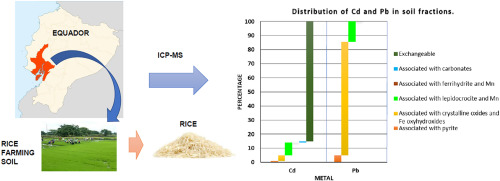Environmental Pollution ( IF 7.6 ) Pub Date : 2020-01-27 , DOI: 10.1016/j.envpol.2020.114050 Martin Ochoa 1 , Wladimir Tierra 1 , Diego Santiago Tupuna-Yerovi 2 , Danilo Guanoluisa 1 , Xosé Luis Otero 3 , Jenny Ruales 1

|
Rice is the world's most consumed and in-demand grain. Ecuador is one of the main rice-consuming countries in Latin America, with an average per capita consumption of 53.2 kg per year. Rice cultivation takes place under flooding conditions, which favors the mobilization and subsequent accumulation of heavy metals in the plant. This study's principal objective was to evaluate the contamination of cadmium (Cd) and lead (Pb) in the rice cultivation system in the province of Guayas. To this end, extensive sampling of water, soil and rice grains was carried. Water samples were analyzed to determine physicochemical properties and concentrations of dissolved Cd and Pb. Physicochemical properties, total organic carbon (TOC), total content of nitrogen (N), iron (Fe), manganese (Mn), phosphorus (P), bioavailable phosphorus (P mehlich), Cd and Pb were determined in soil samples. In addition, to understand the dynamics of Cd and Pb mobility and bioavailability, an extraction of six randomly selected soil samples was carried out. The concentration values of the total Cd and Pb content in the rice cultivation system did not exceed the maximum recommended limit for soil, water and rice grains. However, 85% of the total Cd was in the soluble or exchangeable fraction of the soil, while the Pb was strongly bound to crystalline iron oxyhydroxides. It was established that the TOC, N, Fe, and P mehlich have a significant correlation (p < 0.05) with the overall concentration of Cd and Pb in the rice farming soil. The Cd and Pb present in rice do not represent a dietary health risk to the population of Ecuador.
中文翻译:

厄瓜多尔瓜亚斯省水稻种植土壤和水稻(Oryza sativa L.)中镉和铅的污染评估。
大米是世界上消费量最大和需求最大的谷物。厄瓜多尔是拉丁美洲主要的水稻消费国之一,人均每年消费53.2公斤。水稻种植是在洪水条件下进行的,这有利于植物中动员和随后重金属的积累。这项研究的主要目的是评估瓜亚斯省水稻种植系统中镉(Cd)和铅(Pb)的污染。为此,对水,土壤和稻米进行了大量采样。分析水样品以确定理化性质和溶解的Cd和Pb的浓度。理化特性,总有机碳(TOC),总氮(N),铁(Fe),锰(Mn),磷(P),生物利用磷(P mehlich),测定土壤样品中的镉和铅。此外,为了了解Cd和Pb迁移率以及生物利用度的动态变化,对六种随机选择的土壤样品进行了提取。稻作系统中镉和铅的总含量的浓度值不超过土壤,水和稻谷的最大推荐限量。但是,总Cd的85%位于土壤的可溶或可交换部分,而Pb则与结晶的羟基氧化铁牢固结合。已经确定,TOC,N,Fe和P mehlich与水稻耕作土壤中Cd和Pb的总浓度具有显着的相关性(p <0.05)。大米中的镉和铅对厄瓜多尔人的饮食健康没有危害。为了了解Cd和Pb迁移率以及生物利用度的动态变化,对六种随机选择的土壤样品进行了提取。稻作系统中镉和铅的总含量的浓度值不超过土壤,水和稻谷的最大推荐限量。但是,总Cd的85%位于土壤的可溶或可交换部分,而Pb则与结晶的羟基氧化铁牢固结合。已经确定,TOC,N,Fe和P mehlich与水稻耕作土壤中Cd和Pb的总浓度具有显着的相关性(p <0.05)。大米中的镉和铅对厄瓜多尔人的饮食健康没有危害。为了了解Cd和Pb迁移率以及生物利用度的动态变化,对六种随机选择的土壤样品进行了提取。稻作系统中镉和铅的总含量的浓度值不超过土壤,水和稻谷的最大推荐限量。但是,总Cd的85%位于土壤的可溶或可交换部分,而Pb则与结晶的羟基氧化铁牢固结合。已经确定,TOC,N,Fe和P mehlich与水稻耕作土壤中Cd和Pb的总浓度具有显着的相关性(p <0.05)。大米中的镉和铅对厄瓜多尔人的饮食健康没有危害。稻作系统中镉和铅的总含量的浓度值不超过土壤,水和稻谷的最大推荐限量。但是,总Cd的85%位于土壤的可溶或可交换部分,而Pb则与结晶的羟基氧化铁牢固结合。已经确定,TOC,N,Fe和P mehlich与水稻耕作土壤中Cd和Pb的总浓度具有显着的相关性(p <0.05)。大米中的镉和铅对厄瓜多尔人的饮食健康没有危害。稻作系统中镉和铅的总含量的浓度值不超过土壤,水和稻谷的最大推荐限量。但是,总Cd的85%位于土壤的可溶或可交换部分,而Pb则与结晶的羟基氧化铁牢固结合。已经确定,TOC,N,Fe和P mehlich与水稻耕作土壤中Cd和Pb的总浓度具有显着的相关性(p <0.05)。大米中的镉和铅对厄瓜多尔人的饮食健康没有危害。而Pb与结晶的羟基氧化铁牢固结合。已经确定,TOC,N,Fe和P mehlich与水稻耕作土壤中Cd和Pb的总浓度具有显着的相关性(p <0.05)。大米中的镉和铅对厄瓜多尔人的饮食健康没有危害。而Pb与结晶的羟基氧化铁牢固结合。已经确定,TOC,N,Fe和P mehlich与水稻耕作土壤中Cd和Pb的总浓度具有显着的相关性(p <0.05)。大米中的镉和铅对厄瓜多尔人的饮食健康没有危害。











































 京公网安备 11010802027423号
京公网安备 11010802027423号